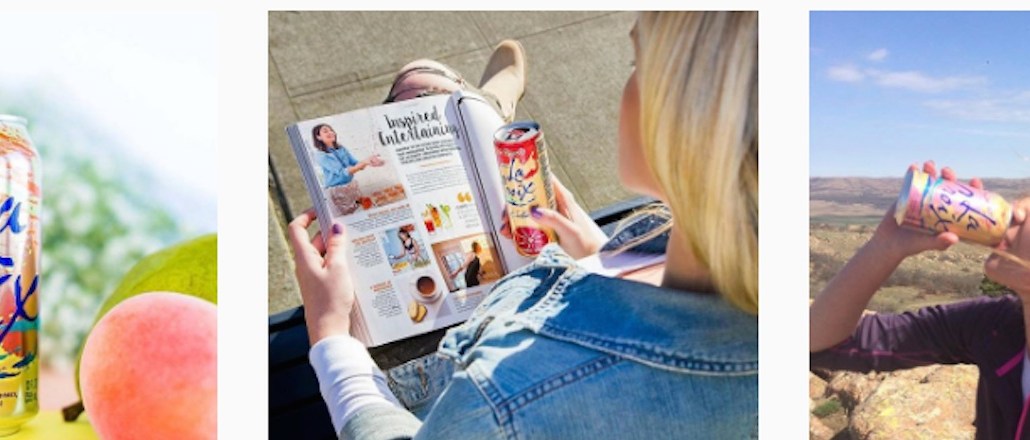Save 50% on a 3-month Digiday+ membership. Ends Dec 12.

LaCroix has elbowed into the crowded sparkling-water market with a fresh approach to digital marketing.
LaCroix’s ascent in recent years lies as much in its unconventional marketing strategy as it does in its neon-colored packaging and the changing beverage landscape, say experts. Unlike its competitors like Nestlé’s Perrier and Pepsi’s Aquafina, LaCroix has bypassed TV advertising and relied on participatory social media campaigns instead, playing into the millennial desire for “authenticity and discovery.”
“The product’s neon-colored packaging gives it that instant pop,” said Toni Box, director of social media and content at PM Digital. “It’s not surprising that people love to pose with it on highly visual social platforms like Instagram.”
LaCroix has recently attached itself to the Whole30 program, for example — a monthlong clean-eating program that is the latest fitness fad. The brand is posting crowdsourced photos of fans with the hashtag #Whole30approved.
It also frequently encourages its fans to use hashtags like #LaCroixlove and #LiveLaCroix and uses social media as a venue to distribute its cocktail and mocktail recipes, said Box. Lifestyle bloggers have pinned and shared their own customized LaCroix recipes on Pinterest.
The brand has specifically turned to Instagram, Alma Pantaloukas, the brand’s former digital strategist, says on her LinkedIn profile. LaCroix looks at the platform to engage with “highly engaged millennials” and “to inspire them to use our products in many different ways and/or stages in life,” she says. It was this focus that turned Instagram into its most engaging platform, growing its fan base from 4,000 to 30,000 within eight months in 2015. (It now has 39,000.)
One tactic is engaging with people who tag the brand, no matter their follower counts. One marketing pro, Kelly Fox, posted a couple of photos with LaCroix cans for her 2,500-plus followers this month and tagged the brand. The brand then sent her vouchers for cases of LaCroix.
“I know that I am being genuinely rewarded for being an advocate, and am not going out there posting on behalf of every other brand like some of the large influencers with huge followings,” said Fox. “It’s a smart strategy for the brand to go after the smaller fish instead of the bigger fish.”
Industry experts agree. LaCroix has found a smart way to blend its product with a compelling “grassroots” influencer approach, said PM Digital’s Box. “Instead of going after influencers with followers in the thousands, they’re actively sharing content on their feed from Instagram users with as low as 150 followers,” she said. “It gives them a more authentic and community-based feel.”
Sparkling water is a growing category in the U.S., growing by 26 percent last year, according to Beverage Marketing Corp, cited by The Wall Street Journal. And LaCroix is the fastest-growing unsweetened brand, with its sales more than doubling in the last two years to $225.5 million, second to Nestlé’s Perrier brand at $339.4 million, according to market researcher Euromonitor International. The 30-year-old brand has become the drink of choice for fitness enthusiasts and Silicon Valley hipsters alike. “The running joke these days is that you know your startup is failing if it switches from LaCroix to Talking Rain,” said Elaine Strauss, a Bay Area professional working for StubHub.
But with Nestlé is expanding flavors and both Pepsi and Coca-Cola increasing investments in their low-calorie, carbonated offerings, competition is heating up. And that means that LaCroix needs to think beyond organic engagement, said Joe Gagliese, CEO of influencer agency Viral Nation.
“This is unique, getting organic reach the way they have is almost akin to winning a social media lottery,” he said. “Being the underdog has helped them so far, but they now need to cash in on the momentum.”
More in Marketing

In Graphic Detail: Here’s what the creator economy is expected to look like in 2026
Digiday has charted its expected revenue, key platforms for creator content as well as what types of creators brands want to work with.

Ulta, Best Buy and Adidas dominate AI holiday shopping mentions
The brands that are seeing the biggest boost from this shift in consumer behavior are some of the biggest retailers.

Future of Marketing Briefing: AI confuses marketers but their own uncertainty runs deeper
That was the undercurrent at this week’s Digiday Programmatic Marketing Summit in New Orleans.





